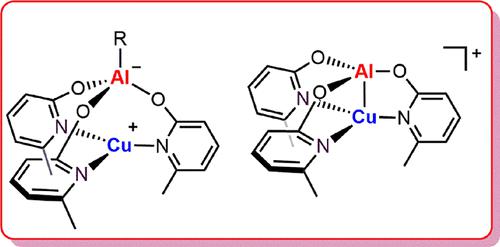当前位置:
X-MOL 学术
›
Inorg. Chem.
›
论文详情
Our official English website, www.x-mol.net, welcomes your
feedback! (Note: you will need to create a separate account there.)
Tuning of Cu–Al Interactions in Complexes Derived from Tris(pyridonyl-6-methyl)aluminum Metalloligands
Inorganic Chemistry ( IF 4.3 ) Pub Date : 2023-01-27 , DOI: 10.1021/acs.inorgchem.2c02273 Omar J García-de-Jesus 1 , Alexander Mondragón-Díaz 1 , Bruno Donnadieu 1 , Miguel-Ángel Muñoz-Hernández 1
Inorganic Chemistry ( IF 4.3 ) Pub Date : 2023-01-27 , DOI: 10.1021/acs.inorgchem.2c02273 Omar J García-de-Jesus 1 , Alexander Mondragón-Díaz 1 , Bruno Donnadieu 1 , Miguel-Ángel Muñoz-Hernández 1
Affiliation

|
A series of bioinspired polar atrane Cu–Al complexes were studied with a combined experimental and computational approach to assess the range and nature of Cu–Al interactions in these novel species. The aluminum metalloligand [Na{Me2Al(OPy-6-Me)2}] (2) was furnished in excellent yield (92%) from the nucleophilic attack of Na(OPy-6-Me) to AlMe3 and the subsequent alkane elimination reaction with 6-methyl-2-hydroxypyridine. At the same time, the metalloligand [Al(OPy-6-Me)3] (3) was isolated in an also excellent yield (95%) via alkane elimination of AlMe3 with 6-methyl-2-hydroxypyridine. The zwitterionic Cu–Al atranes [Cu{MeAl(OPy-6-Me)3}] (5Me) and [Cu{MesAl(OPy-6-Me)3}] (5Mes) were isolated (73 and 97% yields) from metalloligands 2 and 3, respectively. [(Cu{Al(OPy-6-Me)4})2(μ-Cu)]+ ([6+][B(ArCF3)4]) was isolated via a reaction that involves alkane elimination and redistribution reacting from 5Me with [H(OEt2)2][B(ArCF3)4] in benzene solution. Alkane elimination in benzene of either 5Me or 5Mes with [HNEt3][B(ArCF3)4] renders [Cu{(Et3N)Al(OPy-6-Me)3}]+ (Et3N-5+). The Lewis base-free cationic complex [Cu{Al(OPy-6-Me)3}]+ (5+) was isolated in 68% yield upon reacting 3 with [Cu(COD)2][B(ArCF3)4] in benzene. Metalloligands and complexes were fully characterized with an array of spectroscopic and analytical techniques that include multinuclear NMR, ATR-IR, ESI-spectrometry, combustion microanalysis, cyclic voltammetry (CV), and, whenever feasible, SCXRD. X-ray and DFT parameters indicate that the strength of the Cu→Al transannular interaction follows the trend 5+ > Et3N-5+ > [6+][B(ArCF3)4], 5Me, and 5Mes in a smooth transition from zwitterionic species where the Cu–Al interaction is nonexistent to moderate Cu–Al Z-type interactions. CV, in conjunction with DFT calculations of Et3N-5+ and 5+, hint at the generation in the electrochemical cell of the radical species 5rad at −1.82 V and the anionic complex 5– at −2.32 V vs Fc/Fc+, respectively. The proposed species 5rad exhibits 2-center/1-electron (2c/1e) σ bonding whereas 5– a 2-center/2-electron (2c/2e) bond.
中文翻译:

三(吡啶酮基-6-甲基)铝金属配体衍生的配合物中 Cu-Al 相互作用的调节
通过结合实验和计算方法研究了一系列受生物启发的极性阿特烷 Cu-Al 配合物,以评估这些新物种中 Cu-Al 相互作用的范围和性质。铝金属配体 [Na{Me 2 Al(OPy-6-Me) 2 }] ( 2 ) 通过 Na(OPy-6-Me) 对 AlMe 3的亲核攻击以及随后的反应以优异的收率 (92%) 得到与 6-甲基-2-羟基吡啶的烷烃消除反应。同时,金属配体 [Al(OPy-6-Me) 3 ] ( 3 ) 通过用 6-甲基-2-羟基吡啶消除 AlMe 3以同样出色的产率 (95%) 分离。两性离子 Cu-Al atranes [Cu{MeAl(OPy-6-Me) 3}] ( 5 Me ) 和 [Cu{MesAl(OPy-6-Me) 3 }] ( 5 Mes ) 分别从金属配体2和3中分离出来(产率为 73% 和 97%)。[(Cu{Al(OPy-6-Me) 4 }) 2 (μ-Cu)] + ( [6 + ][B(Ar CF3 ) 4 ] ) 是通过一个涉及烷烃消除和重新分布反应的反应分离出来的5 Me与 [H(OEt 2 ) 2 ][B(Ar CF3 ) 4 ] 在苯溶液中。苯中的烷烃消除5 Me或5 Mes与 [HNEt 3 ][B(Ar CF3 ) 4 ] 呈现 [Cu{(Et 3 N)Al(OPy-6-Me) 3 }] + ( Et 3 N-5 + )。无路易斯碱的阳离子络合物 [Cu{Al(OPy-6-Me) 3 }] + ( 5 + ) 在3与 [Cu(COD) 2 ][B(Ar CF3 ) 4反应时以 68% 的收率分离出来] 在苯中。金属配体和配合物通过一系列光谱和分析技术得到充分表征,包括多核 NMR、ATR-IR、ESI 光谱、燃烧微量分析、循环伏安法 (CV) 以及在可行的情况下的 SCXRD。X射线和DFT参数表明Cu→Al跨环相互作用的强度遵循5 + > Et 3 N-5 + > [6 + ][B(Ar CF3 ) 4 ] , 5 Me , and 5 Mes的趋势从不存在 Cu-Al 相互作用的两性离子物种平稳过渡到中等的 Cu-Al Z 型相互作用。CV 与Et 3 N-5 +和5 +的 DFT 计算相结合,暗示在电化学电池中会在 −1.82 V 时产生自由基物质5 rad和在 -2.32 V 时产生阴离子络合物5 – vs Fc/Fc +,分别。提议的物种5 rad表现出 2 中心/1 电子 (2c/1e) σ 键合,而5 – 2 中心/2 电子 (2c/2e) 键合。
更新日期:2023-01-27
中文翻译:

三(吡啶酮基-6-甲基)铝金属配体衍生的配合物中 Cu-Al 相互作用的调节
通过结合实验和计算方法研究了一系列受生物启发的极性阿特烷 Cu-Al 配合物,以评估这些新物种中 Cu-Al 相互作用的范围和性质。铝金属配体 [Na{Me 2 Al(OPy-6-Me) 2 }] ( 2 ) 通过 Na(OPy-6-Me) 对 AlMe 3的亲核攻击以及随后的反应以优异的收率 (92%) 得到与 6-甲基-2-羟基吡啶的烷烃消除反应。同时,金属配体 [Al(OPy-6-Me) 3 ] ( 3 ) 通过用 6-甲基-2-羟基吡啶消除 AlMe 3以同样出色的产率 (95%) 分离。两性离子 Cu-Al atranes [Cu{MeAl(OPy-6-Me) 3}] ( 5 Me ) 和 [Cu{MesAl(OPy-6-Me) 3 }] ( 5 Mes ) 分别从金属配体2和3中分离出来(产率为 73% 和 97%)。[(Cu{Al(OPy-6-Me) 4 }) 2 (μ-Cu)] + ( [6 + ][B(Ar CF3 ) 4 ] ) 是通过一个涉及烷烃消除和重新分布反应的反应分离出来的5 Me与 [H(OEt 2 ) 2 ][B(Ar CF3 ) 4 ] 在苯溶液中。苯中的烷烃消除5 Me或5 Mes与 [HNEt 3 ][B(Ar CF3 ) 4 ] 呈现 [Cu{(Et 3 N)Al(OPy-6-Me) 3 }] + ( Et 3 N-5 + )。无路易斯碱的阳离子络合物 [Cu{Al(OPy-6-Me) 3 }] + ( 5 + ) 在3与 [Cu(COD) 2 ][B(Ar CF3 ) 4反应时以 68% 的收率分离出来] 在苯中。金属配体和配合物通过一系列光谱和分析技术得到充分表征,包括多核 NMR、ATR-IR、ESI 光谱、燃烧微量分析、循环伏安法 (CV) 以及在可行的情况下的 SCXRD。X射线和DFT参数表明Cu→Al跨环相互作用的强度遵循5 + > Et 3 N-5 + > [6 + ][B(Ar CF3 ) 4 ] , 5 Me , and 5 Mes的趋势从不存在 Cu-Al 相互作用的两性离子物种平稳过渡到中等的 Cu-Al Z 型相互作用。CV 与Et 3 N-5 +和5 +的 DFT 计算相结合,暗示在电化学电池中会在 −1.82 V 时产生自由基物质5 rad和在 -2.32 V 时产生阴离子络合物5 – vs Fc/Fc +,分别。提议的物种5 rad表现出 2 中心/1 电子 (2c/1e) σ 键合,而5 – 2 中心/2 电子 (2c/2e) 键合。





















































 京公网安备 11010802027423号
京公网安备 11010802027423号